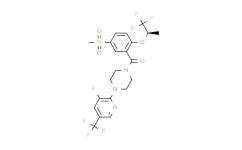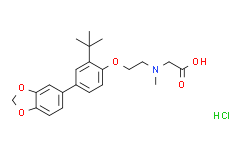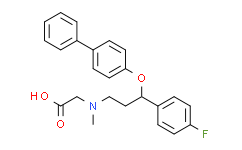| 中文名称: | 比拓喷丁(R型对映体) | ||||
|---|---|---|---|---|---|
| 英文名称: | Bitopertin(Renantiomer) | ||||
| 别名: | 比拓喷丁(R型对映体) RG1678(Renantiomer);RO4917838(Renantiomer) | ||||
| CAS No: | 845614-12-2 | 分子式: | C21H20F7N3O4S | 分子量: | 543.46 |
| CAS No: | 845614-12-2 | ||||
| 分子式: | C21H20F7N3O4S | ||||
| 分子量: | 543.46 | ||||
基本信息
|
产品编号: |
B11329 |
||||
|
产品名称: |
Bitopertin(Renantiomer) |
||||
|
CAS: |
845614-12-2 |
储存条件 |
粉末 |
-20℃ |
四年 |
|
|
|
||||
|
分子式: |
溶于液体 |
-80℃ |
6个月 |
||
|
分子量: |
543.46 |
-20℃ |
1个月 |
||
|
化学名: |
RG1678(Renantiomer);RO4917838(Renantiomer) |
||||
|
Solubility (25°C): |
|||||
|
体外:
|
DMSO |
|
|||
|
Ethanol |
|
||||
|
Water |
|
||||
|
体内(现配现用): |
|
||||
|
<1mg/ml表示微溶或不溶。 |
|||||
|
普西唐提供的所有化合物浓度为内部测试所得,实际溶液度可能与公布值有所偏差,属于正常的批间细微差异现象。 |
|||||
|
请根据产品在不同溶剂中的溶解度选择合适的溶剂配制储备液;⼀旦配成溶液,请分装保存,避免反复冻融造成的产品失效。 |
|||||
生物活性
|
产品描述 |
Bitopertin的R型对映体。Bitopertin是非竞争性甘氨酸重吸收(GlyT1)抑制剂。 |
|
靶点 |
IC50:25nM (GlyT1) |
|
体外研究 |
Bitopertin (RG1678) competitively blocks [3H]ORG24598 binding sites at human GlyT1b in membranes from Chinese hamster ovary cells.Bitopertin potently inhibits [3H]glycine uptake in cells stably expressing hGlyT1b and mGlyT1b,with IC50 values of 25±2nM and 22±5nM,respectively (n=6).Conversely,Bitopertin has no effect on hGlyT2-mediated glycine uptake up to 30μM concentration.Bitopertin has high affinity for the recombinant hGlyT1b transporter.Under equilibrium conditions (1h at room temperature),Bitopertin displaces [3H]ORG24598 binding with a Ki of 8.1nM.In hippocampal CA1 pyramidal cells,Bitopertin enhances NMDA-dependent long-term potentiation at 100nM but not at 300nM.Additional profiling revealed that Bitopertin (RG1678) has an excellent selectivity profile against the GlyT2 isoform (IC50>30μM) and toward a panel of 86 targets including transmembrane and soluble receptors,enzymes,ion channels,and monoamine transporters (<41% inhibition at 10μM is measured for all targets). |
|
体内研究 |
Bitopertin (RG1678) dose-dependently increases cerebrospinal fluid and striatal levels of glycine measured bymicrodialysis in rats.Additionally Bitopertin attenuates hyperlocomotion induced by the psychostimulant D-amphetamine or the NMDA receptor glycine site antagonist L-687,414 in mice.Bitopertin also prevents the hyper-response to D-amphetamine challenge in rats treated chronically with phencyclidine,an NMDA receptor open-channel blocker.Administration of vehicle has no effect on extracellular levels of striatal glycine,which remained constant throughout the experiment.In contrast,p.o.administration of Bitopertin (1-30mg/kg) produced a dose-dependent increase in extracellular glycine levels.Bitopertin 30mg/kg produces glycine levels 2.5 times higher than pretreatment levels.A similar dose-dependent increase in glycine concentration is observed in the CSF of rats treated p.o.with Bitopertin (1-10mg/kg) compared with vehicle-treated animals,3h after drug administration.Interestingly,the level of CSF glycine increase 3h after Bitopertin dosing is very similar to the increase in the microdialysis experiment at the same time point.In vivo pharmacokinetic studies in rat and monkey reveals that Bitopertin (RG1678) has,in both species,a low plasma clearance,an intermediate volume of distribution,a good oral bioavailability (78% for rat,56% for monkey),and a favorable terminal half-life (5.8h for rat,6.4h for monkey).The plasma protein binding is high in the two preclinical species (97%) and in human (98%).The CNS penetration of Bitopertin in rat (brain/plasma=0.7) is better than that in mouse (brain/plasma=0.5). |
推荐实验方法(仅供参考)
|
激酶实验: |
|
Association and dissociation kinetic analysis of [3H]ORG24598 to hGlyT1 and ratforebrain membranes is performed.[3H]ORG24598 binding experiments are performed using membranes from CHO cells expressing hGlyT1b and also in membranes from mouse,rat,monkey,and dogforebrains.Saturation isotherms are determined by adding [3H]ORG24598 to rat,mouse,monkey,and dog forebrain membranes (40μg/well) and cell membranes (10μg/well) in a total volume of 500μL for 3h at room temperature.Saturation binding experiments are analyzed by an Excel-based curve-fitting program using the Michaelis-Menten equation derived from the equation of a bimolecular reaction and the law of mass action:B(Bmax*[F])/(Kd+[F]),where B is the amount of ligand bound at equilibrium,Bmax the maximum number of binding sites,[F] the concentration of free ligand, and Kd the ligand dissociation constant.For inhibition experiments,membranes are incubated with 3nM [3H]ORG24598 and 10 concentrations of Bitopertin for 1h at room temperature. Schild analysis is performed in the presence of increasing concentrations of [3H]ORG24598 (1-300nM).IC50 values are derived as described above.Ki values are calculated according to the following equation:Ki=IC50/(1+[L]/Kd). |
|
动物实验: |
|
|
Mice Male NMRI mice (20-30g) are treated with Bitopertin (0.3,3,1,and 10mg/kg p.o.) or vehicle (p.o.).After 1 min,L-687,414 (50mg/kg s.c.) or vehicle is given.After 15 min of habituation in the activity chambers,horizontal activity is recorded for 60 min.The time course of Bitopertin effects on L-678,414-induced hyperactivity is also examined;locomotor activity is assessed 2.5,4.5,and 24h after administration of Bitopertin (L-678,414 is always given 15 min before the activity procedure).In addition,the effect of subchronic Bitopertin is investigated.Mice receive vehicle or Bitopertin (1mg/kg p.o.) for 4 consecutive days and L-678,414-induced hyperactivity is evaluated on day 5. Rats Wistar rats receive a 14-day treatment of PCP HC1 (5mg/kg) or vehicle (NaCl 0.9%5mL/kg i.p.).24h following the last injection,rats (6-18 per group) are allowed to individually habituate to the test boxes for 30 min.Rats then received Bitopertin (1,3,10mg/kg p.o.) or vehicle (Polysorbate 80,HEC,Methyl-+Propylparaben pH 6.0;5mL/kg p.o.),followed after 1h by 1mg/kg D-amphetamine or vehicle i.p.Horizontal activity is recorded directly after the administration of Bitopertin until 120 min after dosing with amphetamine.Data are analyzed by ANOVA supplemented by Fischer's least significant difference post hoc test. |
|
本计算器可帮助您计算出特定溶液中溶质的质量、溶液浓度和体积之间的关系,公式为:
质量 (g) = 浓度 (mol/L) x 体积 (L) x 分子量 (g/mol)
摩尔浓度计算公式
用本工具协助配置特定浓度的溶液,使用的计算公式为:
开始浓度 x 开始体积 = 最终浓度 x 最终体积
稀释公式
稀释公式一般简略地表示为:C1V1 = C2V2 ( 输入 输出 )










